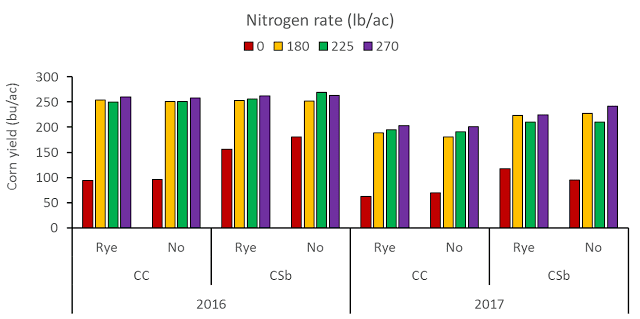In Minnesota, approximately 500,000 acres of irrigated farmland are highly productive but susceptible to nitrate leaching to groundwater. Irrigated sandy soils are especially vulnerable to leaching. A recent study from University of Minnesota, with support from Pope County SWCD and the Minnesota Department of Agriculture, evaluated the use of winter rye as a cover crop in corn production. Early results show that a rye cover crop can help reduce nitrogen leaching in a corn after soybean rotation by 45%
We conducted this study in 2016, an optimal year for corn, and 2017, a wetter and colder year. At the end of each season, the data were analyzed to determine what effect treatments had on nitrogen leaching, yield and economic optimum nitrogen rates (EONR). The addition of rye to a continuous corn (CC) rotation had no effect on nitrate leaching. However, under a corn/soybean (CSb) rotation, rye reduced nitrate leaching by 45% for 2016-17. This is likely because rye residue is tying up residual nitrate early in the spring when there is high precipitation and little crop uptake. As the season continues, the rye decomposes and nitrogen is released into the system when the plants are consuming nutrients. This allows the plants to utilize the nutrients, rather than losing them through leaching.
The preliminary data show promising results with rye decreasing nitrate leaching without negatively impacting yield or EONR. We found that rye had no effect on corn yield in either rotation. The presence of rye had an inconsistent effect on the EONR. In 2016, the EONR for rye plots in CSb was 50 lbs N/ac less than the conventional (no rye) treatments. In 2017, the EONR for rye plots in CSb was 17 lbs N/ac greater than for no rye treatments.

|
Two-year corn yield for continuous corn (CC) and corn-soybean rotation (CSb) with and without a rye cover crop present between fall and spring before corn seeding.
|
Along with the rye cover crop, the crops received urease treated urea in four split applications at corn development stages V2, V6, V8, and V12. Nitrogen rates of 0, 90, 180, 225, and 270 lbs N/ac were used to predict the EONR.
What does this mean for your operation? In this study, the use of cereal rye on irrigated soils worked best for a CSb rotation. The use of fertigation to apply N in multiple split applications over the growing season may also help to reduce N loss. Researchers continue to evaluate new practices for nitrogen and water quality management. With the goal of helping farms perform more efficiently and reducing agricultural pollution, we will continue to investigate best management practices.




Post a comment
Report Abusive Comment